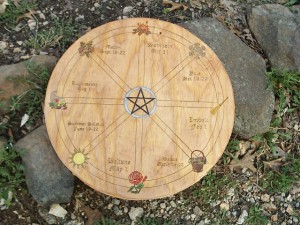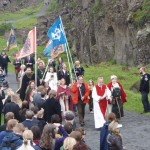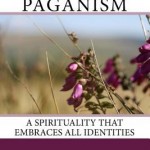Different Pagan traditions have different festivals. The Heathen community celebrates its own cycle of festivals. Wiccans, Druids, and many eclectic Pagans celebrate the eightfold Wheel of the Year. Polytheists have their own festivals too, usually based on the particular ethnic tradition they are working with.
The festivals of specific Pagan paths
- The Eightfold Wheel of the Year & the Druid Festivals by Philip Carr-Gomm. An exploration of the Druidic symbolism of the festivals of the Wheel of the Year.
- Heathen rites, festivals and practices – BBC religion page introducing Heathenry, its festivals, rituals, and practices.
- Traditional Heathen Festivals (UK) – WikiPagan. A list of festivals celebrated by Heathens in the UK based on historical festivals and festivals from British folklore. Other festival lists exist based on the solar year, the lunar year and monthly festivals dedicated to individual gods and goddesses. The celebration of festivals varies greatly between groups and individuals who will only celebrate the festivals they consider the most relevant to their path. Typically a festival year will include three, eight or twelve of the following festivals.
- Calendar of Religio Romana festivals – Nova Roma. There were many festivals in ancient Rome, dedicated to various different deities, and commemorating mythological events. Some of them were major events involving the whole city; others were small local affairs for the devotees of a particular deity.
- Kemetic festivals – Kemet.org. The Kemetic Orthodox faith celebrates many festivals, both ancient and modern. These include major holidays such as Wep Ronpet (the Kemetic New Year), Aset Luminous, and Wag Festival. All of these festivals and many more (there’s nearly one for every day of the year!) can be found in the ancient calendars. While they do celebrate the ancient traditions, it’s not always known exactly how every festival was celebrated or all of the ritual events which took place. As a living and modern faith, Kemetics find as much information as they can on these ancient traditions and celebrate them in a modern way, both together in person and from afar. They’ve also created some entirely modern celebrations to honor the Gods.
The Wheel of the Year – Wiccan and Druid

Samhain (31 October) – Samhain
Samhain is a festival honouring ancestors. It is also the “harvest of meat” when cattle would be slaughtered before the winter. To the ancient Celts, however, Samhain was a festival of liberation from oppression. In East Anglia, it was known as Hollantide. Many Wiccans use Samhain rituals to honour, remember, and commune with our loved ones who have passed on.
Samhain is the Irish word for the month of November. The ancient Irish festival held at this time was about the renewal of freedom – legends associated with it tell of heroes who freed their people from bondage. So the association with the dead was probably imported to this country by Christianity, as this was the feast of All Saints and All Souls. After the Reformation, of course, the importance of these festivals was downplayed, and by the early 20th century, folklorists were speculating that the origins of All Hallows were actually Pagan. The first stirrings of the Pagan revival started in the early 20th century, so the idea of Samhain being associated with the dead was imported into Paganism.
Pagans tend to focus on the preciousness of this life, not some future one beyond death. Hence we want to celebrate and remember the lives of our ancestors. Ancestors can be relatives and friends who have died, or people from the past whom we admire (we often honour both). These people have shaped who we are now – given us life, given us inspiration, guided us, comforted us, and nurtured us – and it comforts us to remember them and commune with them.
Many people believe in reincarnation, and that the consciousness resides in an in-between place between lives. In Paganism, the dead are seen as not being very far away – only a heartbeat away – and many Pagans say that “the veil between the worlds is thin” at Samhain, because the tides of life are on the ebb as winter approaches, and because the encroaching darkness of winter is seen as a time for contemplation, remembrance, and introspection.
Pagans do not see darkness and death as evil, but as part of the cycle of life, death, and rebirth. If there was no death, there would be no growth, no change, and no birth. If there was no darkness, the seeds could not gestate in the warm darkness of the earth; if there was no night, there would be no sleep, and no stars and moonlight. If there was no winter cold, there would be none of the beauty of autumn, the seeds would not germinate, and germs would not be killed by the frost. Darkness is the Yin spoken of by the Taoists – one half of the divine dance of the cosmos.
Samhain or Hallowe’en is part of the dance of the elements around the wheel of the seasons, one of the many interlocking cosmic cycles of which our lives are an intimate part.
In many cultures, especially in Mexico, All Souls is the Day of the Dead – Dia de los Muertos – when people go to visit family graves, and set up altars for them in the home. This is not a morbid practice, but an acknowledgement of death in the midst of life, death as part of the natural cycle.
So why should we reintegrate this festival into our spiritual practice? Because in Britain, death is swept under the carpet, ignored and feared. If we acknowledged it (at least once in the year), it would be an invitation to live more fully and mindfully. If we ignore it, it becomes part of the shadow, the part of our psyche that we reject and that contains our fears and follies, and which we project onto other people: the Other, the outsider, the transgressor.
Whereas if we recognise death as being part of the natural cycle, like the seasons of the year, then we can live more integrated lives, living in and for the moment.
Samhain is also the time when, as the nights get longer and the winter grips the land, we descend into our own depths. Summer is a time for being extrovert, creative and expansive; winter is a time for curling up by the fireside and going within oneself to find the poetic, the spiritual and the quiet side of ourselves – the forgotten aspects, perhaps even the side of ourselves that we have repressed and need to examine.
The presiding deity of winter is the Crone Goddess. She has been feared and denigrated in recent centuries – people speak of old wives’ tales, haggard old witches muttering in corners, and so on. But traditionally, old women were the ones who were the keepers of stories and other traditional wisdom such as herb lore and midwifery. She is the midwife and the one who washed, anointed and laid out the dead, the one who cuts the cord of both life and death. She represents merciful release; but she also possesses the wisdom of old age. Wisdom is traditionally represented as a feminine being or quality. Wisdom is the joining together of instinct and experience and knowledge. It is the wisdom of the body, the knowledge of when to act and when to refrain from acting, when to speak and when to keep silent. Wisdom comes from reflection upon experience and knowledge.
The Crone is also the Goddess of the Waning Moon, which represents a time of letting go and ebbing away, so it is traditional at Samhain to let go of aspects of your life that you do not need or want any more.
Yule (21 December) – Alban Arthan
The winter solstice is the point in the year when the day is at its shortest. The sun rises at its furthest south, and rises in roughly the same place for three days, hence the name “solstice”, meaning “Sun stands still”.
When I was a kid, I was told that ancient pagans used to light bonfires on top of hills at the winter solstice because they feared that the sun would not return after the longest night. I don’t know if there is any truth in this idea, but I remember finding it thrilling.
The Anglo-Saxons called the festival Yule; the Old Norse word was jól.
The earliest references to Yule are by way of indigenous Germanic month names (Ærra Jéola (Before Yule) or Jiuli and Æftera Jéola (After Yule). It has been speculated that the word means “turning point”, but the etymology is unclear.
At Autumn Equinox, we begin the descent into winter. At Samhain, we meet the ancestors and the beloved dead. At Yule, the furthest point in the descent of the Sun, we begin to emerge from the creative and introspective phase of winter, and start thinking about the first stirrings of Spring. The sun represents the core aspect of the personality in many esoteric symbol-systems, and so its descent into the underworld represents a journey into our own subconscious, our own depths, to bring up fertile material to feed a time of creativity. Of course we know that the Sun doesn’t literally descend into the underworld, but in many mythologies, that is where the Sun god goes.
Yule is also a time for enjoyment; the harvest is over and done, there is little work to do in the dark time of the year, so it is time to feast, sing, dance, make merry, and kindle plenty of lights (to make up for the lack of sunshine, and to remind the sun that we would like it to start rising further north again!)
Imbolc (2 February) – Imbolc
Imbolc is a festival celebrating the lactation of ewes, the coming of lambs, and the first stirrings of spring. The name means either “ewes’ milk” (Oimelc) or “in the belly” (im bolg).
In Ireland, Imbolc is the feast of Brigit, originally a Goddess, and now a saint. The Goddess Brigit is associated with healing, poetry, and smithcraft. The saint is associated with them too, and with the perpetual flame tended by the nuns of Kildare – which possibly goes back to pre-Christian times. There are numerous folk-customs and stories associated with Brigit.
Candlemas (also on 2 February) is the Christian festival of the Purification of the Virgin, when Mary presented Jesus at the Temple forty days after his birth, to complete her purification after childbirth in accordance with the Torah.
Both these festivals have traditionally focused on the increasing light and life as the days lengthen and the trees start to blossom and bud. They are also a celebration of goddesses.
Spring Equinox (21 March) – Alban Eilir
Spring Equinox is a festival of balance, as day and night are equal (but after this the days get longer). It’s also the time when the coming of spring is really becoming apparent. According to Bede, the ancient Germanic pagans honoured a goddess called Eostre. She was later conflated with Ostara by the Brothers Grimm, who said she was associated with hares and the Moon and eggs; however there is no reference to this goddess in any other text, so much of the modern mythology associated with her is extrapolated from Bede, and does not have any basis in older mythology. That does not mean that it is not valid as mythology, just that people should not claim ancient origins for it. There are also some other, more interesting, myths around the Spring Equinox, such as the Easter Fox.
Beltane (1 May) – Beltane
Beltane is a festival celebrating sacred sexuality. It is typically celebrated by jumping over fires and dancing round maypoles. Pagan rituals often include symbolic expressions of sexuality.
A celebration of Beltane could include celebration of sexuality in all its forms. It could also include celebrations of the senses, and something to honour the coming of spring and the renewal of life.
Midsummer (21 June) – Alban Hefin
Midsummer is a festival celebrating the Sun. At this time of the year, the days are at their longest, so the Sun is said to be at the height of its power. However, after Midsummer, the days will get shorter, so the Sun is said (symbolically) to descend into the underworld. The Sun is a metaphor for our consciousness; as we descend into the depths of winter, the self goes inward and becomes more introspective.
A celebration of midsummer could focus on the aspects related to consciousness, and emphasise the shift from outward to inward preoccupations.
Lammas (1 August) – Lughnasadh
Lammas commemorates the death of John Barleycorn, the dying-and-resurrecting vegetation god. The corn was believed to be inhabited by the corn-spirit, which was killed at every harvest and resurrected in the planting of the new corn. In Ireland, Lammas was celebrated with games in honour of the goddess Tailtiu, the mother of Lugh the sun god, and was called Lughnasadh. The harvest is an important symbol of cyclicity, growth, and change. The wheel turns, and what has grown must die, so that the seeds can be planted for the new cycle of growth.
Autumn Equinox (21 September) – Alban Elued
At the Autumn Equinox, day and night are equal (but after this the nights get longer), so most rituals focus on this, and on the importance of balance. The festival is also said to honour the Celtic god Mabon, who was imprisoned in a tower for many years. It’s also the fruit harvest; for this reason, I associate it with the Roman deities Pomona and Vertumnus. A celebration of Autumn Equinox could focus on the sensual delights of food and the harvest of work and creativity, as well as the balance of light and dark.
In China, they see life as the balance of opposites – yin and yang, night and day, life and death, eternally cycling around each other in the great dance of existence, the dynamic equilibrium of nature. Equilibrium means “equal freedom” – freedom to move, to grow and to change; freedom of choice.
This dynamic balance of opposites can also be seen in the dance of the seasons. The wheel of the year turns; falling in the autumn, rising in the spring. As it falls in the autumn, and the nights draw in, we turn inward, towards home, and hearth, and spiritual things; baking, and making jam and wine; creative projects.
In British folk traditions, there are three harvests; the corn harvest at Lammas; the fruit harvest at Autumn Equinox; and the harvest of meat at Samhain, when some of the cattle would have been slaughtered and preserved for the winter.
A celebration of Autumn Equinox could focus on gratitude for food and the harvest of work and creativity, as well as the balance of light and dark.
This post is part of a series, Paganism for Beginners. All the posts in this series will appear in the category ‘A Beginner’s Guide‘.
















